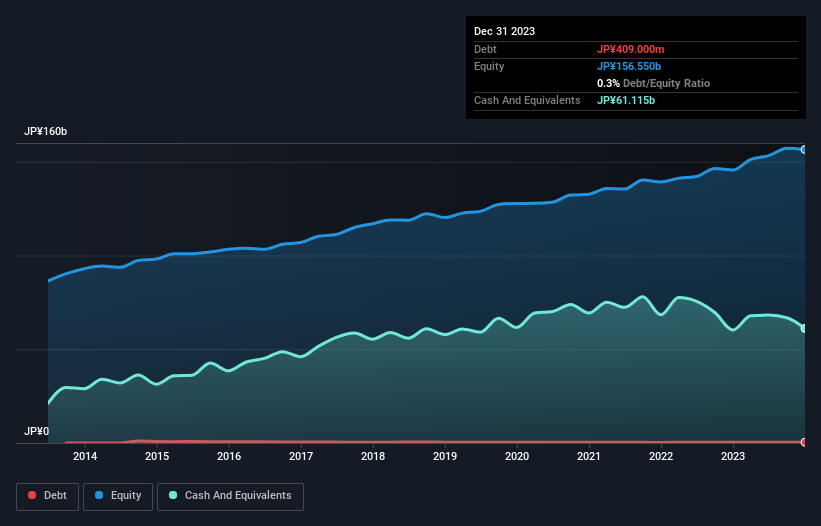- Japan
- /
- Trade Distributors
- /
- TSE:9934
Inaba Denki SangyoLtd (TSE:9934) Seems To Use Debt Rather Sparingly
The external fund manager backed by Berkshire Hathaway's Charlie Munger, Li Lu, makes no bones about it when he says 'The biggest investment risk is not the volatility of prices, but whether you will suffer a permanent loss of capital.' It's only natural to consider a company's balance sheet when you examine how risky it is, since debt is often involved when a business collapses. Importantly, Inaba Denki Sangyo Co.,Ltd. (TSE:9934) does carry debt. But the more important question is: how much risk is that debt creating?
Why Does Debt Bring Risk?
Generally speaking, debt only becomes a real problem when a company can't easily pay it off, either by raising capital or with its own cash flow. In the worst case scenario, a company can go bankrupt if it cannot pay its creditors. While that is not too common, we often do see indebted companies permanently diluting shareholders because lenders force them to raise capital at a distressed price. Having said that, the most common situation is where a company manages its debt reasonably well - and to its own advantage. The first step when considering a company's debt levels is to consider its cash and debt together.
See our latest analysis for Inaba Denki SangyoLtd
What Is Inaba Denki SangyoLtd's Debt?
As you can see below, at the end of December 2023, Inaba Denki SangyoLtd had JP¥409.0m of debt, up from JP¥387.0m a year ago. Click the image for more detail. However, it does have JP¥61.1b in cash offsetting this, leading to net cash of JP¥60.7b.

How Healthy Is Inaba Denki SangyoLtd's Balance Sheet?
The latest balance sheet data shows that Inaba Denki SangyoLtd had liabilities of JP¥79.5b due within a year, and liabilities of JP¥6.52b falling due after that. Offsetting these obligations, it had cash of JP¥61.1b as well as receivables valued at JP¥95.9b due within 12 months. So it actually has JP¥71.0b more liquid assets than total liabilities.
This surplus liquidity suggests that Inaba Denki SangyoLtd's balance sheet could take a hit just as well as Homer Simpson's head can take a punch. On this view, lenders should feel as safe as the beloved of a black-belt karate master. Simply put, the fact that Inaba Denki SangyoLtd has more cash than debt is arguably a good indication that it can manage its debt safely.
And we also note warmly that Inaba Denki SangyoLtd grew its EBIT by 11% last year, making its debt load easier to handle. The balance sheet is clearly the area to focus on when you are analysing debt. But you can't view debt in total isolation; since Inaba Denki SangyoLtd will need earnings to service that debt. So if you're keen to discover more about its earnings, it might be worth checking out this graph of its long term earnings trend.
Finally, a business needs free cash flow to pay off debt; accounting profits just don't cut it. Inaba Denki SangyoLtd may have net cash on the balance sheet, but it is still interesting to look at how well the business converts its earnings before interest and tax (EBIT) to free cash flow, because that will influence both its need for, and its capacity to manage debt. Looking at the most recent three years, Inaba Denki SangyoLtd recorded free cash flow of 32% of its EBIT, which is weaker than we'd expect. That's not great, when it comes to paying down debt.
Summing Up
While it is always sensible to investigate a company's debt, in this case Inaba Denki SangyoLtd has JP¥60.7b in net cash and a decent-looking balance sheet. And it also grew its EBIT by 11% over the last year. So we don't think Inaba Denki SangyoLtd's use of debt is risky. When analysing debt levels, the balance sheet is the obvious place to start. But ultimately, every company can contain risks that exist outside of the balance sheet. For instance, we've identified 1 warning sign for Inaba Denki SangyoLtd that you should be aware of.
If you're interested in investing in businesses that can grow profits without the burden of debt, then check out this free list of growing businesses that have net cash on the balance sheet.
New: AI Stock Screener & Alerts
Our new AI Stock Screener scans the market every day to uncover opportunities.
• Dividend Powerhouses (3%+ Yield)
• Undervalued Small Caps with Insider Buying
• High growth Tech and AI Companies
Or build your own from over 50 metrics.
Have feedback on this article? Concerned about the content? Get in touch with us directly. Alternatively, email editorial-team (at) simplywallst.com.
This article by Simply Wall St is general in nature. We provide commentary based on historical data and analyst forecasts only using an unbiased methodology and our articles are not intended to be financial advice. It does not constitute a recommendation to buy or sell any stock, and does not take account of your objectives, or your financial situation. We aim to bring you long-term focused analysis driven by fundamental data. Note that our analysis may not factor in the latest price-sensitive company announcements or qualitative material. Simply Wall St has no position in any stocks mentioned.
About TSE:9934
Inaba Denki SangyoLtd
Provides electrical equipment and materials, industrial automation, and proprietary products in Japan.
Flawless balance sheet with solid track record and pays a dividend.
Market Insights
Community Narratives





